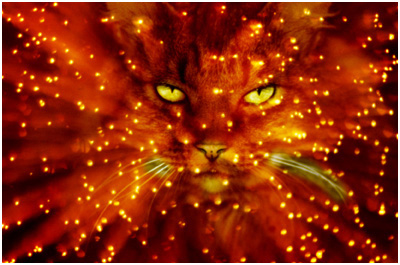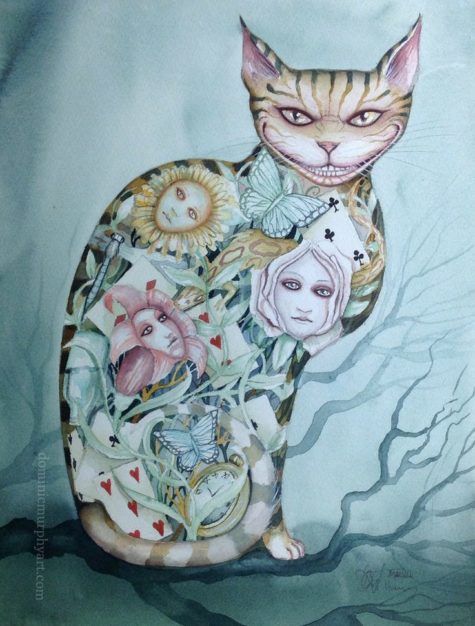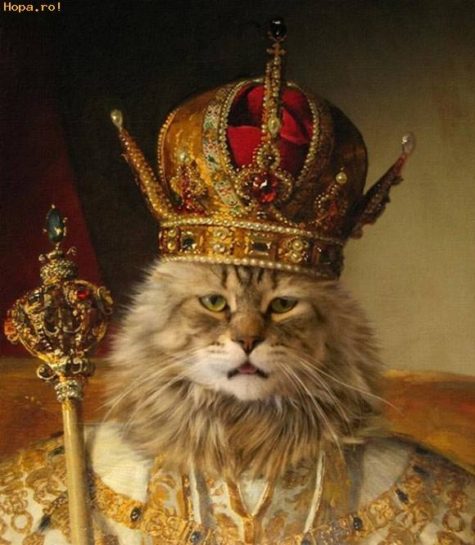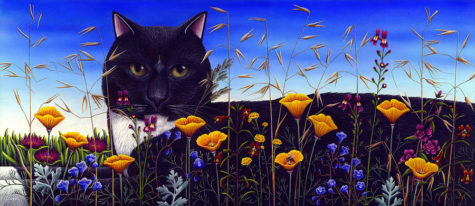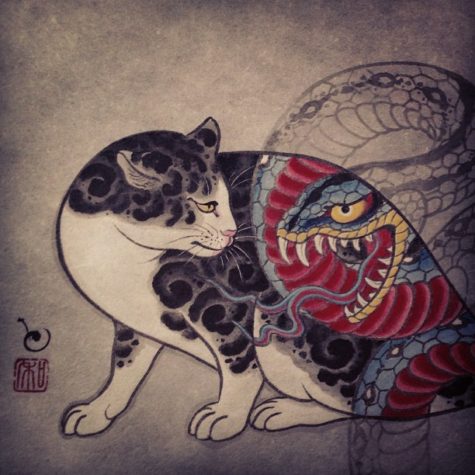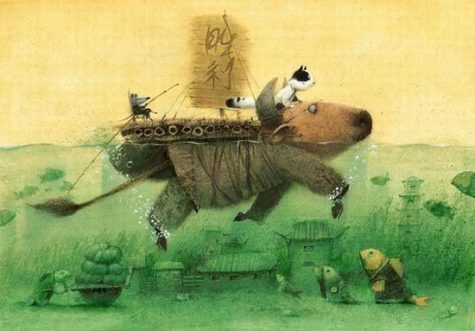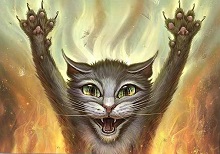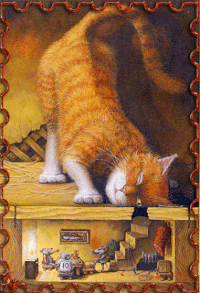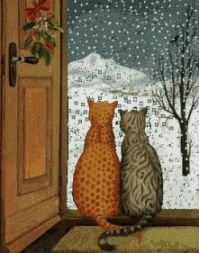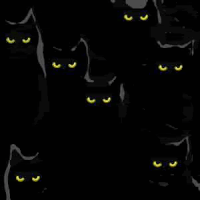Mythological Cats
I Am The Cat
The Cat
A Curious Anecdote
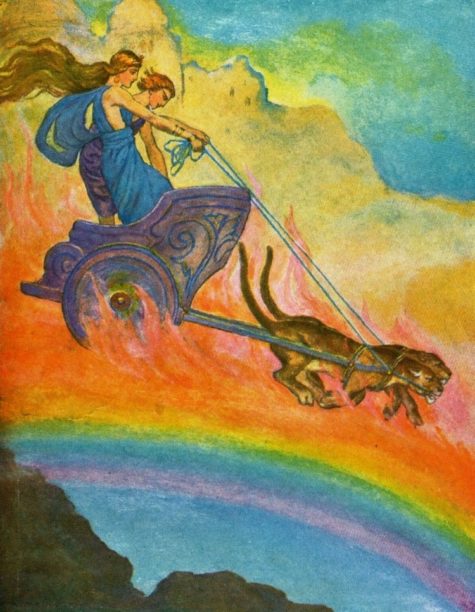
In the epic poem known as “The Kalevala” (composed by Elias L”nnrot and first published in 1835, though based on traditional folktales), you will find this curious anecdote…
It seems that a witch decided to one day invite herself into a house that happened to be filled with people. Upon entering this house the witch began to dance around while muttering bizarre incantations, much to the chagrin of all who were present.
All at once, the people found themselves transported onto a sleigh drawn by a giant magical cat. This mysterious cat pulled the sleigh at fantastic speeds until it finally came to “Pohjola”, a place where evil resides in everlasting night, located deep within the hinterlands of Finland.
Why? How come? What did those people ever do to the witch? How did a cat get mixed up in all this, anyhow? And why decide to ask such questions NOW?
Actually, the Finns believed that cats led the souls of the departed through the obstacles of hell onto the glories of heaven.
This motif of “cat-as-guide-to-the-beyond” is rather common. In Egypt there is the story of Bast the cat goddess bringing souls to the underworld. Babylonians believed that the souls of priests were whisked to paradise by the agency of a benevolent cat. So perhaps the Finnish folktale of the witch and the cat-sleigh isn’t so odd after all.
Why the Ashanti Cat Sleeps Inside
…And because of the cat’s loyalty, and the dog’s jealous vindictiveness, the Chief of the tribe uttered these words:
“From this day on cat, you shall sleep inside upon my finest mats, while you, dog, shall continue to sleep out of doors upon the dust of the earth. And when the time comes that we feast, O cat, thou shall eat of the same food as we, being a worthy and noble being. But you, dog, shall learn to be content and satisfied with what scraps we choose to toss you.”
Paraphrased from an Ashanti legend.
The King of the Cats
Here’s a great cat story from Ancient Legends, Mystic Charms, and Superstitions of Ireland, by Lady Francesca Speranza Wilde, published in 1887.
A most important personage in feline history is the King of the Cats. He may be in your house a common looking fellow enough, with no distinguishing mark of exalted rank about him, so that it is very difficult to verify his genuine claims to royalty. Therefore the best way is to cut off a tiny little bit of his ear. If he is really the royal personage, he will immediately speak out and declare who he is; and perhaps, at the same the, tell you some very disagreeable truths about yourself, not at all pleasant to have discussed by the house cat.
A man once, in a fit of passion, cut off the head of the domestic pussy, and threw it on the fire. On which the head exclaimed, in a fierce voice, “Go tell your wife that you have cut off the head of the King of the Cats; but wait! I shall come back and be avenged for this insult,” and the eyes of the cat glared at him horribly from the fire.
And so it happened; for that day year, while the master of the house was playing with a pet kitten, it suddenly flew at his throat and bit him so severely that he died soon after.
A story is current also, that one night an old woman was sitting up very late spinning, when a knocking came to the door. “Who is there?” she asked. No answer; but still the knocking went on. “‘Who is there?” she asked a second the. No answer; and the knocking continued. “Who is there?” she asked the third time, in a very angry passion.
Then there came a small voice–“Ah, Judy, agrah, let me in,–for I am cold and hungry; open the door, Judy, agrah, and let me sit by the fire, for the night is cold out here. Judy, agrah, let me in, let me in!”
The heart of Judy was touched, for she thought it was some small child that had lost its way, and she rose up from her spinning, and went and opened the door–when in walked a large black cat with a white breast, and two white kittens after her.
They all made over to the fire and began to warm and dry themselves, purring all the time very loudly; but Judy said never a word, only went on spinning.
Then the black cat spoke at last–“Judy, agrah, don’t stay up so late again, for the fairies wanted to hold a council here tonight, and to have some supper, but you have prevented them; so they were very angry and determined to kill you, and only for myself and my two daughters here you would be dead by this time. So take my advice, don’t interfere with the fairy hours again, for the night is theirs, and they hate to look on the face of a mortal when they are out for pleasure or business. So I ran on to tell you, and now give me a drink of milk, for I must be off.”
And after the milk was finished the cat stood up, and called her daughters to come away.
“Good-night, Judy, agrah,” she said. “You have been very civil to me, and I’ll not forget it to you. Good-night, good night.”
With that the black cat and the two kittens whisked up the chimney; but Judy looking down saw something glittering on the hearth, and taking it up she found it was a piece of silver, more than she ever could make in a month by her spinning, and she was glad in her heart, and never again sat up so late to interfere with the fairy hours, but the black cat and her daughters came no more again to the house.
Borrowed from: Widdershins
Cat Symbolism and Lore
Even the most common household cat has a mystique about it and the potential for the supernatural powers that man has ascribed to cats for thousands of years.
At various times, and in different places, it has been regarded as a holy or a diabolical beast, as a bringer of good fortune or as an omen of evil. In antiquity it was sacred to more than one divinity.
Artemis / Diana, the Goddess of the Hunt was associated with the cat, also notorious for its hunting skills. The followers of Diana revered cats because they were under her special protection, and because she once assumed that form. So too, in pagan Scandinavia, Freya, the goddess of love and fertility, was associated with them, her chariot was drawn by them.
Typically, in Western civilizations, the cat (particularly if it is black) belongs to the witch; it is her familiar, her companion and her alter ego. As such, the cat shares magickal secrets and arcane knowledge which, of course, she cannot explain to mere mortals, since they don’t speak her language. There is an unspoken communication between the witch and her grimalkin that transcends any language used by other creatures.
In the Saga or Eric the Red, there is a very complete description of a witch or prophetess that was a mistress of rune-craft, the art of reading the runes. Part of the description of her costume includes a hood “lined with white cat skin” and “cat-skin mittens.”
When it sleeps, the cat curls itself into a circle with its head touching its tail, making a shape that is very similar to the ouroboros. Like this ancient mythical creature, the cat is a symbol of immortality.
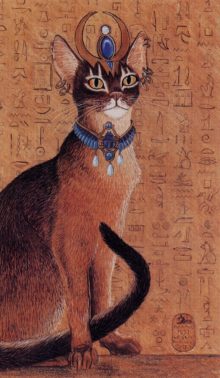 The Ancient Egyptians regarded the cat so highly that they revered it as a deity. The Egyptian Bast, or Pasht, was cat-headed and attended by cats, and consequently every member of the cat family was loved and venerated in ancient Egypt. To kill one was sacrilege. When a household pet died, its owner shaved off his eyebrows as a token of mourning and performed funeral rites for it.
The Ancient Egyptians regarded the cat so highly that they revered it as a deity. The Egyptian Bast, or Pasht, was cat-headed and attended by cats, and consequently every member of the cat family was loved and venerated in ancient Egypt. To kill one was sacrilege. When a household pet died, its owner shaved off his eyebrows as a token of mourning and performed funeral rites for it.
Bast was the cat goddess, and mortal cats whose fur was of three different colors, or who had eyes of different shades were honored in particular for their Bast-like appearance; it is not just the black cat that holds power. Bast is often depicted with a knife in her paw, having beheaded Apophis, the enemy of the Sun.
Egyptian priests believed that cats carried the magnetic forces of nature and so close proximity to the creatures enabled them to access these powers. If a cat died a natural death in the home, the Egyptians would shave their eyebrows as a sign of mourning.
It was in ancient Egypyt that the belief began that a black cat crossing your path brings good luck. The opposite tradition began in the Middle Ages in Europe.
Cats fared badly during the dark times of the Middle Ages because of the association between witches and cats. Black cats were believed to be witches in disguise. An alternative belief was that after seven years of service to a witch, a black cat would turn into a witch. Consequently, a black cat crossing your path was an indication of bad luck, as the devil was watching you.
The cat does not an honorable reputation in the Buddhist tradition either. Because it was absent at the physical death and spiritual liberation of the Buddha, it is viewed with suspicion as a base, earthly creature, lacking respect, which really should have been present at such an auspicious occasion. The only other creature that was not there was the serpent.
The link between the cat and the serpent comes in the Kabbalah, too, and also in Christianity; in pictures where the cat appears at the feet of Christ it carries the same negative imagery as the snake.
In Islam, cats are regarded favorably unless they are black, in which case they are viewed with great suspicion since djinn can transform themselves into black cats. Additionally, the magical powers of the cat are ambivalent, used either for or against man, this refers to the indifference with which a cat treats its prey.
In the Western tradition of cat lore, the animal has nine lives, whereas its Eastern cousin has to manage with only seven.
A Persian belief about the cat echoes the idea of the witch with her familiar. Some people are born with a hemzad, a spirit that accompanies the person throughout his or her life and takes the form of a cat. That its blood is particularly powerful for writing charms further underlines the universally “magical” nature of the cat.
In Africa, too, the clairvoyant powers of the animal are renowned, and so medicine bags made of cat skin are imbued with supernatural powers.
Interestingly, the cat is not in the Chinese Zodiac. One folktale explanation is that heard Buddha saw Cat playing with mice for fun and did not allow that kind of sin into the zodiac.
Another folk story tells that Cat and Rat were the worst swimmers in the animal kingdom. Although they were poor swimmers, they were both quite intelligent. To get to the meeting called by the Jade Emperor, they had to cross a river to reach the meeting place. The Jade Emperor had also decreed that the years on the calendar would be named for each animal as they arrived to the meeting.
Cat and Rat decided that the best and fastest way to cross the river was to hop on the back of Ox. Ox, being naive and good-natured, agreed to carry them both across. Midway across the river, Rat pushed Cat into the water. Then as Ox neared the other side of the river, Rat jumped ahead and reached the shore first. So he claimed first place in the competition and the zodiac.
Borrowed from: Sigils Symbols and Signs
